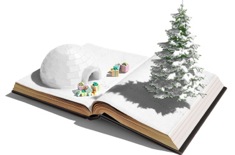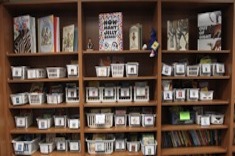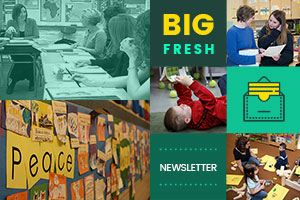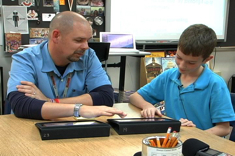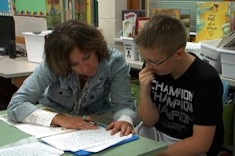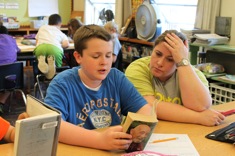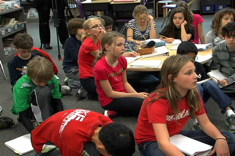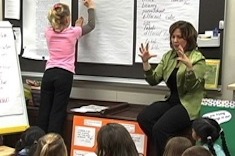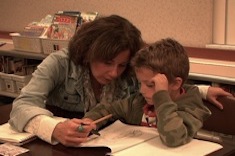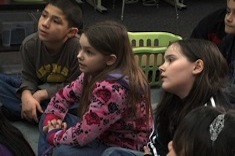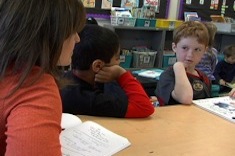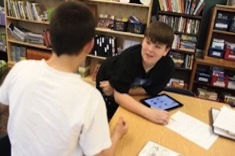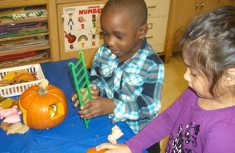Library
Choice Literacy Articles & Videos
The Choice Literacy library contains over 3,000 articles and 900 videos from 150+ contributors. Classic Classroom and Literacy Leadership subscribers have access to the entire library. Content is updated continuously, with five to six new features published each week.
Latest Content
Exploring Winter with Short Texts
Middle school teachers Megan Ginther and Holly Mueller focus on winter in short texts as the theme of their December Literacy Contracts in the latest installment of their year-long series.
Curating a Nonfiction Classroom Library
Franki Sibberson writes about how her thinking about nonfiction is changing her classroom library in this first installment of a four-part series.
The Big Fresh November 23, 2013 Abandoning Books
Conferring is the focus of this week’s Big Fresh.
Reporting and Crafting: Conferring with Ezra
Ruth Ayres confers with Ezra about revision — using a mentor text to help him move from reporting to crafting in his writing.
Writing a Strong Ending: 4th Grade Writing Conference
Tony Keefer confers with fourth grader Tommy to help him write a stronger ending.
Powerful Conferences
Ruth Ayres explains how deciding the purpose of conferring in advance can lead to more powerful conferences.
Better Reading Conferences
Katherine Sokolowski describes how she worked over the past few years to initiate better reading conferences.
The Big Fresh November 16, 2013 First Fruits
Connecting classrooms with tech tools is the focus of this week’s Big Fresh.
Thinking About Theme
Karen Terlecky explains how she designs instruction and uses mentor texts to teach theme, and includes a video example of a minilesson.
The Big Fresh November 9, 2013 The Ultimate Desk Challenge
How to teach theme is the focus of this week’s Big Fresh.
Kindle Highlights: Conferring with Nicole
If you’ve ever used a Kindle reader, you might be fascinated by the highlighted notes of other readers. Franki Sibberson uses those notes in a conference with Nicole.
November Contract: Family and Memoir
The November installment of Megan Ginther and Holly Mueller’s yearlong literacy contract series has a theme of family and memoir.
Shared Blogging in the Primary Classroom
Shared reading and shared writing are essential instructional techniques in the primary grades. How about shared blogging for teaching children basic blogging skills? Cathy Mere describes how it works.
The Big Fresh November 2, 2013 Running and Reading
Student partnerships are the focus of this week’s Big Fresh.
Dandelions, Chinese, and Patience with Our Youngest Learners
Kelly Petrin meditates on the importance of trust and patience when looking for ways to connect with preschoolers.
Two Lessons for Teaching Theme
Franki Sibberson writes about how she chooses books for theme instruction and shares two lessons.
Illustrations in Kindergarten: Conferring with Dalton
Ruth Ayres confers with kindergartner Dalton early in the year, focusing on his illustrations to build storytelling skills.
Finding a Writing Buddy
Beth Lawson helps her fourth graders sort through what makes peer collaboration work during writing buddy time.
Partner Reading Conference in First Grade
Katie DiCesare confers with Jack and Praneel about their partner reading.
Learning from Kidwatching
Quiet kindergartners can be a challenge to understand when they are in the beginning stages of learning social and academic norms. Andie Cunningham uses observation to make sense of five-year-old Sierra’s learning.
The Big Fresh October 26, 2013 PD Overload
We consider gender issues in reading and writing in this week’s Big Fresh.
Strong Girls Book Group
Franki Sibberson shares a range of books that include compelling female characters with a group of fourth-grade girls.
Choice, Content, and Format: Understanding How Boys Write
Katherine Sokolowski is dismayed when many of the boys in her fifth-grade class admit they don’t like to write. She explains how she changed her writing program to meet their needs.
She Wants to Be Katniss for Halloween: Courageous Girls in Books
Shari Frost celebrates a tomboy who finally finds a female character she wants to emulate with a booklist highlighting courageous girls.
Pumpkin Time: Provocations and Stories with Preschoolers
Kelly Petrin reinvents a pumpkin decorating project with her preschoolers to help them build storytelling skills.
The Big Fresh October 19, 2013 Tending the Garden
Flexible grouping is the focus of this week's Big Fresh.
Exploring Explanatory Moves Writers Use
Jeff Anderson explores the difference between informational and explanatory writing, and what that might mean for teaching craft moves to students.
Research Book Clubs for Struggling Readers
Beth Lawson finds that a nonfiction research book club is just the grouping structure needed for a group of struggling readers in her fourth-grade classroom.
Group Conference in First Grade
Katie DiCesare meets with first graders Anna and Brendan to help them learn from each other and prepare to share their rereading strategies with the whole class.
The Big Fresh October 12, 2013 Winning Deal
Communicating with families is the focus of this week’s Big Fresh.
Browse Content By
Type
Category
- Assessment Tools
- Big Fresh Archives
- Booklists
- Choice Numeracy
- Classroom Design
- Common Core
- Community Building
- Conferring
- Content Literacy
- Digital Literacy
- English Language Learners
- Equity
- Family Relations
- Free Samples
- Guiding Groups
- Leadership
- Literacy Coaches
- Mentor Texts
- Minilessons
- New Teacher Mentors
- Podcasts
- Poetry
- Quote Collections
- Reading Strategies
- Self Care
- Struggling and Striving Learners
- Talking and Listening
- Teacher Study Groups
- Teaching Reading
- Teaching Writing
- Word Study and Vocabulary
Author
- Melissa Quimby
- Nawal Qarooni
- Gwen Blumberg
- Julie Cox
- The Lead Learners
- Hannah Tills
- Josie Stewart
- Ruth Metcalfe
- Mallory Messenger
- Becca Burk
- Jodie Bailey
- Vivian Chen
- Mary Brower
- Tiffany Abbott Fuller
- Stephanie Affinito
- Ruth Ayres
- Leigh Anne Eck
- Heather Fisher
- Shari Frost
- Julie Johnson
- Suzy Kaback
- Gigi McAllister
- Shirl McPhillips
- Melanie Meehan
- Cathy Mere
- Debbie Miller
- Tara Barnett and Kate Mills
- Tammy Mulligan
- Dana Murphy
- Bitsy Parks
- David Pittman
- Brenda Power
- Heather Rader
- Matt Renwick
- Mandy Robek
- Christy Rush-Levine
- Gretchen Schroeder
- Jen Schwanke
- Brian Sepe
- Katherine Sokolowski
- Stella Villalba
- Jennifer Vincent
Grade Level
Choice Literacy Membership
Articles
Get full access to all Choice Literacy article content
Videos
Get full access to all Choice Literacy video content
Courses
Access Choice Literacy course curriculum and training

